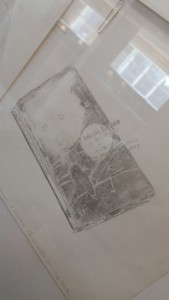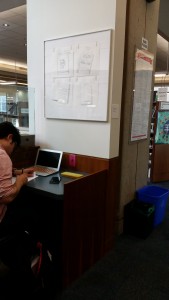Lili and the Migratory Influences
Bernadette Phan’s Lili and the Migratory Influences is an ongoing collection of drawings that feature books from the artist’s late aunt’s Paris library. It is an elegy to Phan’s Aunt Lili, but also an exploration of the multitude of influences one encounters everyday, and their role in the creative process. The exhibit is located in the second floor of the Bob Prittie Library in Burnaby, and is distributed around the study area teeming with students.
Nobody gives the drawings a second thought until they notice someone leaning over their desk, trying to make out what the light pencil marks are forming a picture of. They quickly scan what has been above their heads all this time, then go back to studying. The writing is all in French. They don’t notice the small white cards with descriptions located at a right angle to the wall.
Many of the books depicted by Phan are somewhat familiar; and many are not. Antoine de Saint-Exupery’s The Little Prince stands out. It is a French book, but to this English-speaker, it belongs among the needing-to-be-translated in the collection. The rush of recognition and nostalgia such a widely-read book invokes is indicative of the power of translation. Because one knows the book in one’s own language, one feels something of an ownership over it. Because the other, less familiar books might be in a language one is not familiar with, a barrier is created.
Lili and the Migratory Influences was previously exhibited in Marseille, France. There, the language barrier would not have been an issue, but being as versatile as the collection is, a number of other questions might have arisen. What does it mean to transport a compilation of someone’s influences and evidence of their artistic growth to another place, one which has a different primary language? What does it mean to give something that is about movement and migration, the ability to move locations and move people in a different part of the world? Would the exhibit have to be translated in order to move as it would have done in France?
Phan keeps it as it is, and adds new “readings” of her aunt now and again. With every drawing, she translates her aunt for herself. However, in featuring any language, the artist inevitably creates the need of translation for others. She creates a division even as viewers are invited to look closer into someone’s life.
Lili and the Migratory Influences is an interesting exhibit about movement, fluidity and artistry. It takes a unique approach through depicting activity through still life. However, the language it is in and the location create barriers for the viewers who may wish to look closer.

